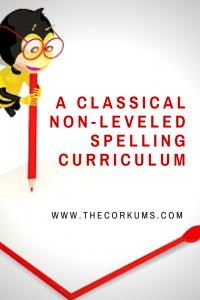We started our classical education journey at a small, local, private school. When we started homeschooling, we joined a local Classical Conversations community, and now we’ll be starting a new classical community, using memory work from Claritas Classical Academy, improving on what we’ve learned over the past 4 years. As my understanding of classical methodology has deepened, I find myself tweaking curriculum to meet our family’s needs and stay as simple as possible.
I developed this methodology for spelling in our family when I was homeschooling all 6 of our kids who ranged from 7 to 16 and included special needs and non-native English speakers. I needed a system that worked across multiple levels (and wasn’t leveled), worked within our budget, and required minimum mom-help.
Spelling Foundations
I’m an engineer and I like to be able to answer the “whys” in life. Phonograms and spelling rules make it so that there are actually very few exceptions when reading and spelling. Starting at around 4 or 5, children should start drilling and memorizing the phonograms that are the building blocks to spelling English words. These should be drilled daily (or at least multiple times a week) until mastered, then reviewed a couple times a month. (Check out my ABC’s at Home for a multi-sensory curriculum for introducing the single-letter phonograms).
Spelling Schedule
Once your student has mastered the phonograms, he can start mastering spelling lists. It would be nice if our kids mastered a list a week, but sometimes that doesn’t happen. Instead, I recommend working a list until it’s mastered, then moving on. You can just ignore that they’re labelled by week…
Day 1: Watch the appropriate spelling lesson video. Set A are beginner lists, Set B are intermediate, and Set C are advanced. There are 22 lists in each set. They are sourced from CC’s EEL program which are sourced from Spelling Power.
The rest of the days: Test your student on the list (or send them to Spelling City to test). If they get 100%, start over on Day 1 with the next list. Otherwise, have your student practice any incorrect words using these Spelling Review Ideas.
Weekly: Drill one spelling rule a week.
Last thoughts:
You can obviously use this methodology with your own lists. You’ll just have to teach the Day 1 lesson instead of using the video. I teach a word by saying the word so it can be heard, using the fingerspelling visual from SWR, and writing the word using SWR markings for visualization. I then ask the student to repeat the and spell the word verbally (spelling bee style) so the sequence of letters can be heard and file appropriately. I also try to link the word to the appropriate rule as they apply.
For non-writers, I love the All About Spelling phonogram tiles. You can buy them or print them.
For an interesting lecture by Andrew Pudewa (of IEW fame) on Spelling and the Brain, go here.

Image courtesy of pixtawan | FreeDigitalPhotos.net
I used SWR for K5 and 1st grade for a mathy boy whose reading lagegd his vocabulary, phonetic awareness, and spelling. He enjoyed the challenge of memorizing the flash cards, the spelling rules, and interpreting Mother’s finger-hints. Since he could spell much more complex words than he could read, it was a morale booster for both of us. The title doesn’t quite make it clear this is much more a learn to read book than a set of spelling lessons.The example sentences in the Wise Guide are often Bible-based, and one can substitute on the fly. While the author is clear on her faith, it is not needlessly repeated throughout the book.I did not do the full-court press program, but picked and chose an enrichment here and there, and tended to sit down and do all the cards, rather than fishing out the ones advised for that particular lesson. I also found the Spell to Write and Read book (not the Wise Guide) in need of a strict editor, and ran a quick pencil slash through the many extraneous paragraphs. Rather like a wet Persian cat, the meat of the program is less intimidating once it is its actual size. Look for the Quick and Dirty Guide for getting started with it for free on Lulu.I’m very glad we grounded ourselves (for really, I learned a lot, too!) with SWR, and it was a shared experience between the two of us. It would be much harder if you have a pack of kids not doing it in unison. And you do need a day of peace to read and get the flow of the program. This was perfect for me, as I’d never taught anyone anything, and it gave me a distinct path to follow while I got my pegs beneath me. Once kiddo was reading, we have moved on to a pure spelling program for that.